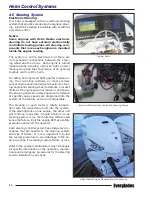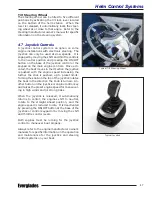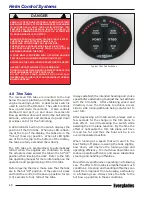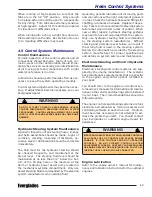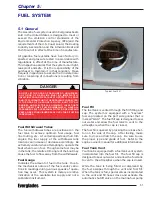
43
HELM CONTROL SYSTEMS
4.1 General
The helm controls consist of three systems: the
engine throttle and shift controls, the steering
system, and the trim tab control switches. These
systems provide the operator with the ability to
control the direction and attitude of the boat from
the helm station.
Each manufacturer of the control components
provides an owner’s manual with its product. It is
important that you read the manuals and become
familiar with the proper care and operation of the
control systems.
4.2 Engine Throttle & Shift Controls
Electronic Engine Controls
The shift and throttle controls on your boat may
vary depending on the engines used and control
system selected. Refer to the engine or control
manuals for specific information on the controls
installed on your boat.
The helm is designed for a binnacle style control
with a single lever for each engine. The electronic
control system consists of three major compo-
nents: the electronic control head, instruments
and keypad, the control processors and applicable
harnesses. The controls are completely electronic
and there are no cables.
The controls have a single lever for each engine
that operates as a gearshift and a throttle. Gen-
eral operation will include a position for neutral
(straight up and down or slightly aft of vertical),
a forward position (the 1st detent forward of neu-
tral), and a reverse position (the 1st detent aft
of neutral). Advancing the control lever beyond
the shift range advances the throttle in forward or
reverse. Each control is equipped with a means of
permitting the engine to be operated at a higher
than idle RPM while in neutral for cold starting
and warm-up purposes. The control levers are
equipped with adjustable control head detent and
friction settings.
The engine controls and key pads have integrated
switches and indicator lights which allow the op-
erator to control all aspects of the boat’s propul-
sion system. LED lights on the control pad indicate
Chapter 4:
that the control is activated and the engines can
be started.
The most common features activated or
monitored by the keypad are:
• Starter lockout, which prevents the engine
from being started in gear.
• Gear lockout, which allows engine RPM to be
advanced in neutral safely.
• Battery voltage warning indicator that warns
the operator of high or low voltage supplied
to the system (audible alarm)
Typical Yamaha Twin Engine Electronic Control
Summary of Contents for 340 DC
Page 1: ...OWNER S MANUAL 340 DC...
Page 2: ...2 Revision 0 11 07 2018...
Page 14: ...14 NOTES...
Page 22: ...22 NOTES...
Page 25: ...25 Operation...
Page 86: ...86 NOTES...
Page 102: ...102 NOTES...
Page 122: ...122 NOTES...
Page 130: ...130 NOTES...
Page 149: ...149 MAINTENANCE LOG Appendix B Hours Date Dealer Service Repairs...
Page 150: ...150 Maintenance Log Hours Date Dealer Service Repairs...
Page 151: ...151 Maintenance Log Hours Date Dealer Service Repairs...
Page 152: ...152 Maintenance Log Hours Date Dealer Service Repairs...
Page 153: ...153 Maintenance Log Hours Date Dealer Service Repairs...
Page 154: ...154 Maintenance Log Hours Date Dealer Service Repairs...
Page 155: ...155 Appendix C BOATING ACCIDENT REPORT...
Page 156: ...156 Boating Accident Report...
Page 157: ...157 Boating Accident Report...
Page 158: ...158 NOTES...
Page 160: ...160 NOTES...
Page 167: ...CAUSE AND SOLUTION...


















